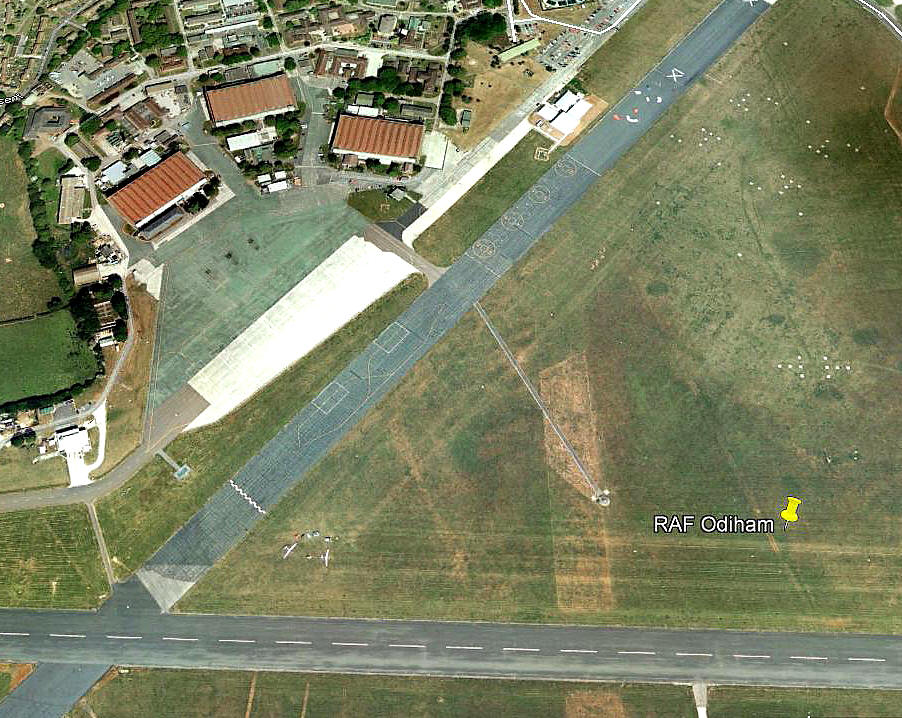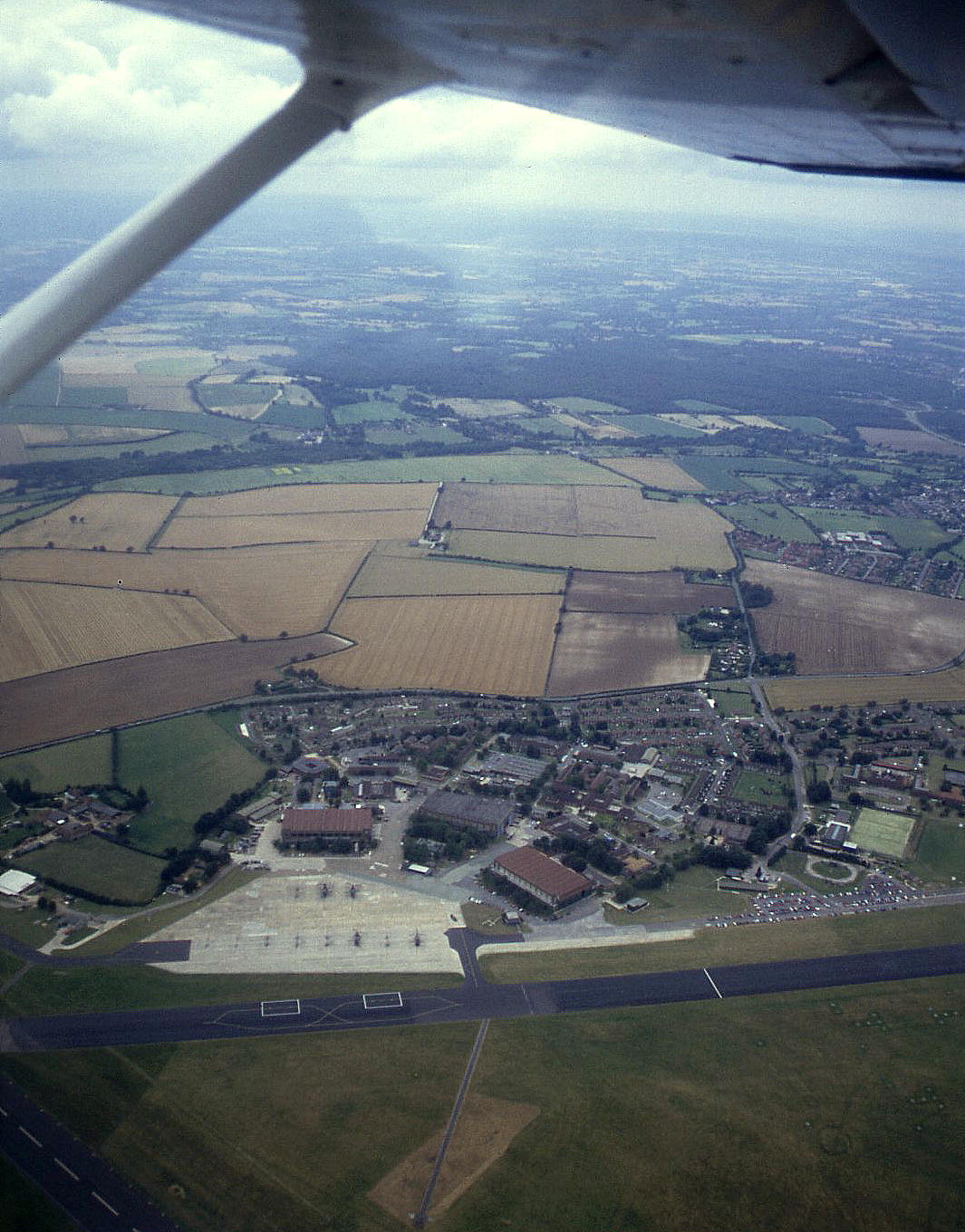Odiham
ODIHAM: Military Landing Ground later military aerodrome
Note: These pictures were obtained from Google Earth ©
Pictures by the author unless specified.
Military users: RAF: School of Army Co-operation (1920s)
1939: RAF Bomber Command
53 & 59 Sqdns (Bristol Blenheims)
WW2: RAF Fighter Command 11 Group
96 & 604 Sqdns (DH Mosquitos)
225 Sqdn (Westland Lysanders)
Note: Used for Army Co-operation duties)
239 Sqdn (North American P-51 Mustangs)
511 FRU
ODIHAM PICTURES
Note: These three pictures from postcards were kindly sent by Mike Charlton who has an amazing collection: See, www.aviationpostcards.co.uk
Can anybody kindly tell when these pictures were taken? The first two appear to me to be during a period of refurbishment, possibly after WW2? Or, perhaps when under contruction in the 1930s.
Post 1945: RAF Fighter Command
46 Sqdn (Gloster Javelins)
54 & 247 Sqdns (Hawker Hunters)
RCAF 421 (Red Indian) Squadron (Gloster Meteors)
1975: RAF (Westland Wessex & Pumas)
18 & 72 Sqdns (Westland Wessex)
RAF Chinook Centre 7, 18 and 27(R) Squadrons (Chinooks, Pumas)
33 Sqdn (Aerospatialle SA330 Pumas)
240 Sqdn OCU (Chinooks, Pumas)
1998 snapshot: RAF Support Helicopters
7 Sqdn 19 x Chinook HC 2/2A (Some deployed to ALDERGROVE, N. I.)
18 Sqdn 6 x Chinook HC 2
27 (R) Sqdn 7 x Chinook HC 2
Flying Club: No.46 Sqn. R.A.F. Flying Club
Note: This flying club is listed in the 1957 The Aeroplane directory. Membership was restricted to No.46 Squadron personnel but unfortunately no information was provided, (as it was by most other flying clubs and schools), regarding the aircraft operated. Could anybody today kindly offer advice?
Gliding: From 1950, Army Gliding Club. Until?
More recently the Kestrel Gliding Club
Location: E of A32, 1nm S of Odiham, 6nm ESE of Basingstoke, 8nm SW of Aldershot
Period of operation: 1926, (some records say 1924 others 1934 and 1936), to -
The Hampshire Aviation web-site says it was used as a Landing Ground from 1924 becoming a permanent station in 1934 and I suppose they should know?
Note: This map is reproduced with the kind permission of Pooleys Flight Equipment Ltd. Copyright Robert Pooley 2014.
Runways: WW2: 10/28 1554x46 hard 04/22 1280x46 hard
1990/2000: 10/28 1838x46 hard
Also listed in 2000 within the confines of runways 10/28 & 04/22 are ‘Heliland’ areas resembling runways, (presumably grass), 280/100 & 230/050
NOTES: After WW2 in Europe ended ODIHAM became a reception centre for PoWs being flown back. DUNSFOLD, WESCOTT and WING were others. 38 Group Stirlings were certainly landing here bringing back PoWs from Belgium.
THE CORONATION REVIEW
Note: A small item of little interest, I suppose, is that the photographs below clearly illustrate that a couple of changes were made regarding the actual disposition of the aircraft compared to this map.
There was a huge Review for Queen Elizabeth II, (the Coronation Review), held here on the 15th July 1953. A massive fleet of mostly RAF aircraft were assembled on the ground, and an equally impressive array of 639 aircraft conducted the fly-past demonstrations.
To quote from the Aeroplane Monthly article: "The flypast of 639 aircraft, the largest ever undertaken by the RAF, was a triumph of accuracy and timing, its control and organisation being the responsibility of Air Vice-Marshall the Earl of Brandon, then AOC No.11 (Fighter) Group. It was no small task to organise formations from all over the country to fly to the 'gate' at Leavesden and then down the 30-mile corridor to Odiham so that they passed the royal dais with no awkward gaps between the formations, and no overtaking." Organisers of some airshows today - please take note.
"Betwen the Bristol Sycamore that started the flypast and the Hastings there was a speed difference of 95kt, and between the Hastings and the Hunter F.1 a gap of 410kt." Obviously this speed difference wasn't actually required, and so it is evident that as the display progressed, the speed of the aircraft increased leading up to the finale. In other words, the whole affair was not only planned to perfection - it was choreographed! Simply amazing I am sure you will agree.
"The slowest types, the trainers came first, the Chipmunks and Prentices flying at 98 m.p.h., the Harvards, Oxfords and Ansons at 138 m.p.h., the Balliols, Varsities and Valettas at 166 m.p.h., speeds then rising gradually with most of the jet formations flying at 345 m.p.h. Seperation between formations was 30sec for the smaller and faster aircraft, and 45sec for the bigger types such as the Hastings, and the formations flew at between 600 and 1,200ft. The whole flypast lasted half an hour.
THE PRACTICE
"Practice for the flypast started in June; at first only formation leaders participated, then small formations and finally full-strength ones, spotters in the Cambridge, Duxford and Leavesden areas being rewarded with the sight of some of the biggest formations to be seen since the war. A full dress rehearsal of the flypast was held on the July 10, and another one three days later." Obviously nothing was being left to chance, but, can we even imagine such an event happening today.
SOME OF THE AIRCRAFT TYPES FEATURED IN THE FLYPAST
First was the Bristol HC.13 Sycamore helicopter XD196 from 275 Sqdn LINTON-on-OUSE. Then sixteen DHC.1 Chipmunk T.10s from BOOKER (later WYCOMBE AIR PARK) and another sixteen Chipmunk T.10s plus twelve Percival Prentice T.1s from SOUTH CERNEY. Twelve North American T.6 Harvard T.2s then appeared from LITTLE RISSINGTON along with twelve Airspeed Oxford T.2s from WELLESBOURNE MOUNTFORD.
Closely following were twelve Avro Anson T.21s from SHAWBURY, twelve Boulton Paul Balliol T.2s from COTTESMORE, and six Vickers Varsity T.1s from No.1 and No.2 Air Naviation Schools plus six more from 201 AFS all based at THORNEY ISLAND. These were followed by six Vickers Valettas from COLERNE.
Other heavier types included Short Sunderland flying-boats, Avro Lincolns, Boeing B-29 Washington B.1s, Avro Shackletons and Handley Page Hastings. The front runner fighter type was the Hawker Hunter mostly followed by DH Vampires and Gloster Meteors, plus of course the English Electric Canberra medium bomber.
PRETTY MUCH A PRIVATE DO, AT FIRST
Can you believe this? It appears that the original plans were to pretty much exclude the public to a small enclosure - how quaint and how typical of the English 'establishment'; arguably amongst the most corrupted society of people the world has ever seen accordiing to many who have studied the subject.
"In fact, the decision to allow the public into the the static park, after the Queen had completed her tour of inspection was a last minute one, and advance official notice publicity on the Review had tended to dampen public interest by stressing that only a small proportion of those in the public enclosures would be able to see anything but the flypast." Presumably one thoughtful person had pointed out that, as so many had willingly served as 'cannon-fodder' during the five years of 'unpleasantness' a few years before, it might be a good PR idea to let them have a 'gander'.
Oddly perhaps, but these people have no idea about the cost of living etc, (being so well off mostly), the entrance fee to the public enclosure was just one shilling and sixpence. Which can be compared to paying one pound for the public days at the 1953 SBAC Show at FARNBOROUGH that year.
As the Aeroplane Monthly article points out: "Largely because of this the Review attendance was only 40,000 people - about half what it should have been - and by contrast , a big NATO air display at Soesterberg, Holland, three days later, which culminated in a flypast by 300 jet fighters of NATO air forces, was attended by something like 100,000 people." Makes you proud to be British, doesn't it?
SOMETHING TO CONSIDER?
All this is set against the fact that after WW2 the nation was pretty much bankrupt; people were still subject to rationing, (lifted one year later in June 1954), and the costs involved in being a major player in the 'Cold War' to support the USA were already mounting up to a colossal degree. And yet, obviously, we managed as a nation to not only cope, but most managed to prosper - eventually.
What strikes me as being so impressive is the amount of organisation involved in staging the review. And the arrangement of the ground display itself is quite staggering considering the size of ODIHAM airfield. How on earth did they manage to land all these aircraft before setting them out?
PICTURE GALLERY OF THE CORONATION REVIEW
These pictures have been scanned from an article, "All the Queens Forces" published in Aeroplane Monthly, October 1988 . An article well worth reading.
Picture captions:
Picture One: This fabulous picture was used to open the article in Aeroplane Monthly.
Picture Two: Three of the twelve Boeing B.29 Washington B.1 bombers arriving to the second for their flypast from RAF MARHAM. Surprising perhaps, considering the occassion, that obviously a photographer not familiar to air-to-air sorties had been selected; using far too fast a shutter speed, resulting in the bombers propellers being seen as stationary!
Picture Three:Looking east, what an incredible nostalgic line-up, and only a part of the ground display.
Picture Four: Looking west, most of the types operated by the RAF in 1953 can be seen in this picture.
AN INFAMOUS 'ACCIDENT'
It was a 7 Squadron Chinook that became infamous after leaving ALDERGROVE loaded with top military and secret service people, then crashing into a hill on the Isle of Mull. Typically the Ministry of Defence and RAF top staff blamed the incident on pilot error which is, by subsequent investigation, obviously ridiculous. The way the RAF and/or Ministry of Defence staff have handled the procurement of the Chinook, especially later types, is a utter disgrace wasting millions of pounds and rendering a proven type nigh on useless, and certainly a liability to fly.
Regarding the latest Chinooks especially it is claimed that the MoD thought they knew better than Boeing who, it seems, insisted the British modifications would not work, rendering the helicopter nigh on useless and highly dangerous to operate. It is said that even with the earlier versions they contained serious flaws. At that time the Chinook crews pretty much knew this! But who I wonder, made the decision to put so many top people on just one aircraft? And, did they suffer repercussions?
ODIHAM PICTURES IN AUGUST 2017
Note: All pictures by the author.
Michael cooper
This comment was written on: 2019-06-03 20:59:26My Father was the Station Warrant Officer there 1966-67 time.
We'd love to hear from you, so please scroll down to leave a comment!
Leave a comment ...
Copyright (c) UK Airfield Guide






































